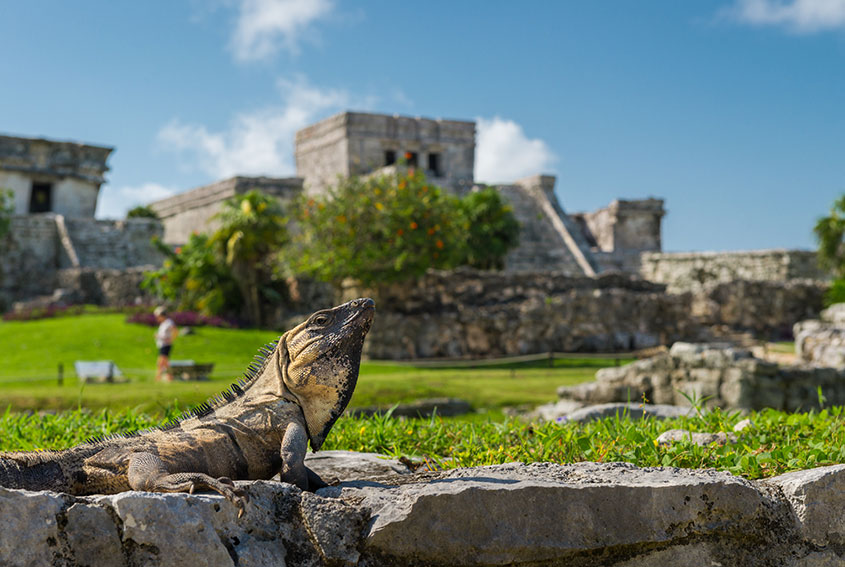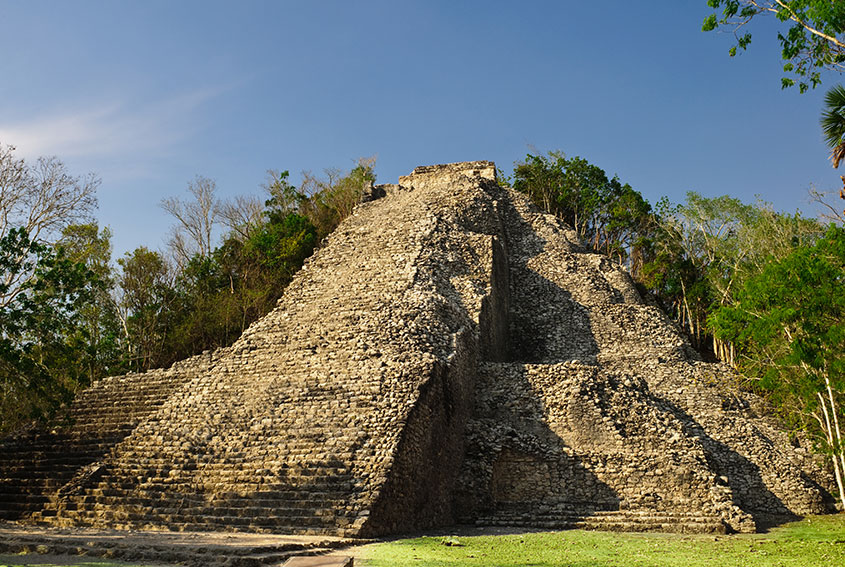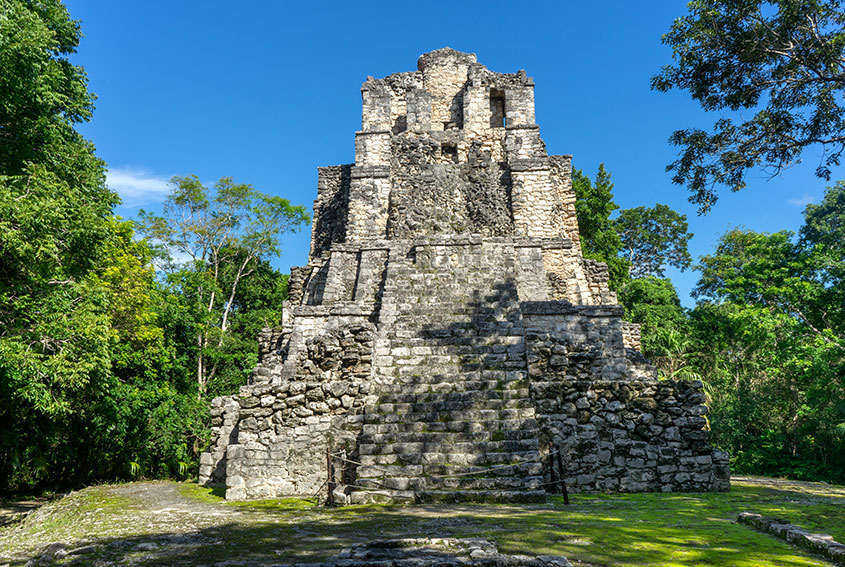Mayan magic
How about visiting this trio of Mayan cities during your stay? Tulum, Muyil and Coba are all in the Riviera Maya and within driving distance although you may want to pace yourself and visit them separately.

The spectacular views of the Caribbean from the cliff top city of Tulum makes this an obligatory Riviera Maya visit and it doesn’t matter how many times you have been there, it is always beautiful, right down to the iguanas basking in the sun on the walls of ancient temples.
Inhabited as far back as AD 564, Tulum reached its peak during the Post-Classic period (1250 – 1521) as a port on the sea and land trade routes. Trading canoes may have anchored in the tiny bay at the foot of the cliff crowned by El Castillo, the principal temple in the city. Trade goods such as jade, obsidian, copper, flint and ceramics have all been found at the site.
Other important temple groupings are the Temple of the Descending God, so named for a sculpted diving figure through to represent a deity, the Temple of the Frescos, the House of the Columns and the Temple of the Wind. The wall that surrounds the city on three sides defended the port from land attacks and distanced the elite from the masses.
Head inland from Tulum on the Mexican Caribbean coast to the ancient jungle city of Coba, one of the largest archaeological sites in the Maya World; it is said that 90 percent of its temples and palaces have yet to be excavated. They are clustered around five shallow lakes, which would have provided inhabitants with fresh water in ancient times, and its name in Maya means “waters ruffled by the wind.”
The city reached its peak during the Mayan Classic period, A.D. 250-900, when it was a regional capital and an important trade center, distributing goods to and from the Caribbean coast, Central America and cities in the Yucatán. Commodities such as honey, beeswax, cotton, henequen, cacao and copal incense that were produced in the region would have been bartered for sting ray spines, spiny oyster shells and salted fish from the coast and jade, obsidian, quetzal feathers and gold from Belize, Guatemala, Honduras and other parts of Central America.

At the height of its power Coba is thought to have had a population of around 70,000 people. Mexican archaeologists identified a dynasty of 14 rulers from the hieroglyphic inscriptions on stelae or standing stones at the site. This powerful house ruled the city from around A.D. 500 to A.D. 780 and had links to Ek Balam, Calakmul and cities in the Peten region of northern Guatemala.
Unlike other Mayan cities in the area, Coba was still inhabited at the time of the Spanish Conquest.
Standing 42 meters high, Nohoch Mul is the tallest pyramid in the northern Yucatán. The pyramid staircase leads to two temples where offerings of animals, conch shells, jade and a fragment of a stela were found.
About 70 meters southeast of the pyramid is Stela 20, the best preserved of 30 stelae, altars and carved panels found at the site. It depicts a lord standing on the back of a bound captive, surrounded by three other courtiers who appear to be paying homage to their ruler.
Other building groups at the site are the Cobá group, the oldest at the site, La Iglesia, another 24-meter-high pyramid crowned by a temple, the Ball Court, Las Pinturas, Xaibé or the Crossroads Pyramid and the Macanxoc group which has nine circular altars and eight stelae.
Coba is also famous for the sacbes or Mayan causeways that radiate from the heart of the city. To date, 45 of these roads have been unearthed at the site, including the longest sacbe in the Maya World, which links the city with Yaxuna, near Chichen Itza, a distance of 101 kilometers. Sacbes were used for ceremonial processions, trade and military missions and to mark the boundaries of a city’s territory and influence.
One of the thrills of exploring Coba is being in the jungle and catching a glimpse of some of the creatures that make their home among the trees. Towering chicozapote trees, tropical figs, cedars, chacas and ceibas compete for space, their branches festooned with vines, orchids and bromeliads. Look up and you may spot flocks of parrots and Yucatan jays, the yellow breast of the shy trogon and a flash of turquoise and russet as a motmot bird takes flight.
Families of spider monkeys move through the canopy in search of zapote fruit and agoutis, brocket deer and coatimundis forage in the undergrowth. Iguanas sun themselves on the rocks and huge morph butterflies in shades of iridescent blue flutter along jungle trails.
After your Coba visit, you might want to cool off with a swim in one of the cenotes in the Tulum area.

Twenty minutes to the south of Tulum, the archaeological site of Muyil, also known as Chunyaxche, is on the shores of a lagoon in the Sian Ka’an Biosphere Reserve. Once a Maya trade center, it received goods brought by canoe from the Caribbean and shipped them overland to other cities in the Yucatan.
You can combine your Muyil visit with an unforgettable boat trip through the Sian Ka’an wetlands to see birds, crocodiles and other wild creatures.
Exploring these three archaeological sites on your Cancun vacation is a chance to have your own jungle experience with plenty of wildlife sightings.
Ready to book your trips?
All these trips and many more can be booked with Thomas More Travel. Visit the website and call in at the tour desk in your resort for more exciting tour and activity recommendations.
